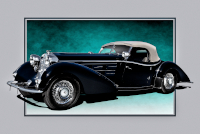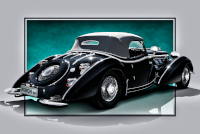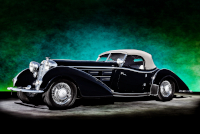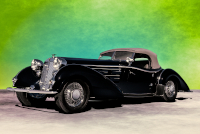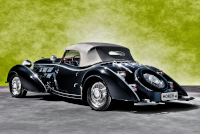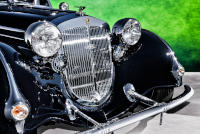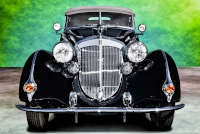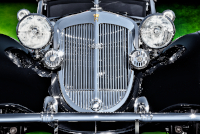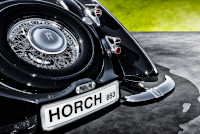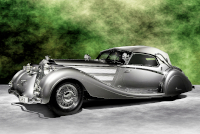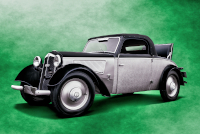Location:
St. Michaels Concours d'Elegance, 2021
Owner: Mr. & Mrs. Robert S. Jepson, Jr. | Savannah, Georgia
Prologue:
Special thanks to Mr. Steve Purdy, who worked with Mr. Jepson to produce a history of #853278. Steve very kindly lent a copy of his book for this profile.
Round about 2021, this Horch Special Roadster had been in the United States for about a year—two at most. The term, 'showstopper,' springs to mind because the roadster precipitates a sudden stop and a quick mental calculation to determine that, yes, this really is what it seems.
In this context, it's important to remember that a car such as the 853 Special Roadster is not exceptional today because of how it ages; its purpose is to be an exclusive art piece, and we rather qualify that objective with present-day admiration more than we add to its mystique. There were only ever a handful, (six of the original eight survive), and a chance encounter today is somewhat more predictable given our appreciation of the species and the proliferation of the modern concours circuit.
Of course, this sort of step-back perspective doesn't diminish the effect. Since we saw #853278 I've been anxious to finish a profile, not in the least because English-language Horch materials are scarce, and our digital acknowledgments are thin. I thank Steve Purdy for helping us avoid more of the same.
So this profile represents a modest effort to provide context for a car so striking that it too often does without. And if I can provide a few interesting visual perspectives in the process, all the better.
- - - - - - - - - -
► Image Source: Nikon D750 (24.3 MP)
References:
- Automobile Quarterly, Volume 33, Number 2, September 1994, "Horch, The August Motor Car" by Hans-Otto Neubauer, The Kutztown Publishing Company, Inc., Kutztown, PA, page 18-19, 21-22, 28-29
- Automobile Quarterly, Volume 4, Number 2, Fall 1965, "Cars Named After August Horch" by Richard von Frankenburg, The Kutztown Publishing Company, Inc., Kutztown, PA, page 140-142, 145
- Purdy, Steve. "The History and Provenance of Bob Jepson's Horch 853 Special Roadster, Coachwork by Erdmann & Rossi, Chassis Number: 853278" Shunpiker Productions, Williamston, MI. 2020, page 10-12, 14, 16-26, 30-32, 36
- RM Sotheby's: Profile of the 1939 Horch 853A Special Roadster by Erdmann & Rossi, chassis #854275. In Purdy's work, an affidavit from Horst Lautenschläger notes that RM consulted him on the restoration of #853278 to support their work on #854275. In terms of authenticity, #853278 is a benchmark, particularly significant given the scant number of Special Roadsters produced.
- UltimateCarPage: Technical specification matches descriptions for the 853 Sport Cabriolet, as the Special Roadster is a custom-coachwork variant. The site also profiles 853A Special Roadster #854275, as above, by Wouter Melissen, October 17, 2005.
- ZF: The manufacturer provides a description of its Aphon transmission and how it works.
The first Horch 853 Special Roadster dates to 1935, designed in-house by Horch using a wooden buck. Chassis #853278 is the second Special Roadster produced, and while Erdmann & Rossi provide the coachwork, they base the shape on Horch's original wooden model. This conceptual blend explains how the car fits so well within the Auto Union aesthetic while at the same time exhibiting a graceful fluidity unlike any of the standard cars.
These few Special Roadsters, of which six survive, are elegant repartee to the Mercedes-Benz 540K Special Roadster. As with the Mercedes, these Horch cars are statement pieces built to establish exclusivity within the range. Numerous sources suggest that Auto Union vetted its clientele to select those of the highest social stature to procure a Special Roadster. Auto Union delivered these few cars to people of significant power, which, through the course of World War II, made the Special Roadster a valuable piece of booty.
In turn, whereas the Horch 853 remains an exceptional rarity in itself, the surviving 853 Special Roadsters are presumptuous messengers from the past; they were created to be admired, and so we fulfill their purpose by doing so today.
History and Discovery: Horch #853278
Other sources describe the original owner, Gustav Petzold, as a banker who became part of the Ministry of Finance. While this title would seem appropriate, research conducted by Steve Purdy and Robert Jepson's team unearthed a number of Gustav Petzolds who may have taken delivery of this car, but their research did not offer a conclusion about which Gustav actually did.
The car's wartime survival is also a mystery. Purdy notes that many high-value German automobiles became property of military and state figureheads, (despite how their owners felt about the appropriation). And as it is highly plausible that the Russian military claimed chassis #853278 at conflict's end, some such transfer of possession to a German official is at least possible. The alternative would mean a private owner, whether Petzold or his successor, would have stowed the car safely enough to avoid appropriation by his government or destruction by the Allies, but not safely enough to avoid confiscation by an advancing army.
Purdy writes, "Horch historians have documented a repair facility in Berlin during Russian occupation that repaired appropriated German staff cars and other equipment using skilled Horch mechanics in a surviving Horch factory. This car could have been among those."
So in 1945, perhaps Horch #853278 appears ripe for the taking in the possession of the German state. Perhaps the Russians hurry the car away back to the east. And perhaps the private owner has had little say in these circumstances.
The Horch does not resurface until 1972, in Poland. Here, a German named Wilfred Scholtz discovers the car, whose Polish owner claims to have recently extracted it from Russia. Scholtz brings #853278 back to Germany. He undertakes the restoration himself, but in 14 years manages only to disassemble the car.
While awaiting attention, another German collector, Horst Lautenschläger, tracks down chassis #853278 in the Scholtz workshop. Wilfred Scholtz does not want to part with the car, but Lautenschläger, a specialist in high-art German cars, manages to negotiate its sale. (Lautenschläger also owned Mercedes-Benz 540K Spezial Roadster #130949).
Keen on the historical value of the car, Lautenschläger sets upon restoring #853278. From this point, the Horch as presently known takes shape.
Horch 853 Special Roadster Restoration
Lautenschläger aims to preserve as much of the original coachwork as possible. Early in the restoration, he presumes roughly 80% of the body can be used.
He trusts the body's reconstruction to Heiko Bachmann of Bachmann Oldtimerrestauration in Malsch, who will also build a new wooden substructure. But differing opinions arise as to how much of the original sheet metal should be used. In this case, Lautenschläger wishes to use more of the original pieces than Bachmann would otherwise choose. And to this point, Lautenschläger writes, "In my eyes there is a big difference in the procedure of a restoration between America and Germany, because our authorities are much stricter in the technical inspection."
This assessment defines the contradiction between Lautenschläger and Bachmann. In the end, Bachmann concedes, "In total there were about fifteen larger and smaller individual sheets, including the bonnet tops, which I laboriously restored with new edging and fitted into the bodywork. The remaining surfaces showed such a strong corrosion attack after the purification process that they were actually not suitable for further use. On a later visit by Mr. Lautenschläger, we nevertheless decided to reuse some of the sheets, although I did not feel that this was technically correct."
So what we see is a process in which Lautenschläger lobbies for preservation against the German inclination to place engineering above all other considerations. The complete restoration is thus a joint effort between Lautenschläger and Bachmann, and the result is more historically sympathetic than a German shop might typically permit.
Concours Itinerary: From Heidelberg to America
For his efforts, Horst Lautenschläger wins Best of Show with his Horch 853 Special Roadster at the 2017 Classic Gala Concours at Schwetzengen Palace. About a year later in May, 2018, he sells the Horch to his friend, Thomas Hamann, of Hamann Classic Cars in Riverside, Connecticut. Hamann enlists the help of Bruce Amster of Redline Automotive Restorations in Black Rock, Connecticut, who collects the Horch from JFK and sets about righting transport woes and mechanical foibles.
Mr. Jepson subsequently acquires #853278 in 2020, and it should be said that his diligence in scrutinizing the vehicle and understanding its history is absolute. Mr. Jepson puts forth considerable time and resources to illuminate exactly what the car is, which leads him and his team to commission Steve Purdy to document its history and restoration.
Chassis #853278 is a remarkably original example of rarefied Auto Union strata; it is the second car of an exclusive production run of eight original exmaples, of which six survive, and even among those the model and coachwork differ. Thank Horst Lautenschläger for insisting on the maximum degree of originality, (to the detriment of German roadworthiness standards), and Heiko Bachmann for making it work.
Now we are in the enviable position of admiring the car, and not for its history—which on the topic of Auto Union is always dubious—but for its extraordinary grace.
Motor: 4,944 cc Type T850 straight 8-cylinder | 87 mm x 104 mm | 6.1:1 compression
Fritz Fiedler and Hans Schleicher simplify Paul Daimler's 8-cylinder plan. In 1926, Paul Daimler designed a long-stroke DOHC design, shaft-driven, with direct valve actuation and accessories driven by a set of 14 bevel and helical gears. The new Fiedler-Schleicher motor is much less complex and of a more conventional bore and stroke (87 mm by 104 mm). Direct valve actuation remains along with vertical shaft drive, but uses a SOHC with belt drive for accessories. Cooling treats each cylinder as a separate unit within the cast-iron block, whereas Daimler had paired the cylinders together to create a short block on five main bearings. So this new design is less of a technology for technology's sake approach, and more of a reasonable plan that provides Horch with respectable flexibility throughout the 1930s.
Valvetrain: SOHC, 2 valves per cylinder
Aspiration: single Solex 35 JFF carburetor
Power: 105 bhp @ 3,200 rpm
Drivetrain: ZF Aphon 4-speed gearbox, rear-wheel drive
Horch models drive the wheels through an Aphon G 30 gearbox developed by ZF in 1929. The unit uses spur gears on first and reverse, and helical gears on second, third, and fourth, the primary advantage being quiet operation. ZF state that 'Aphon' means 'without sound' in Greek. (Take the root 'phōnētikos' meaning 'spoken,' as in 'phonetics' or 'telephone,' then add the Greek prefix 'a-' to the word meaning 'not-' and the meaning is 'soundless.') The gearbox uses a staggered layout with overdrive on all forward gears, providing eight speeds total, a wholly modern concept of luxury that helps the Horch 853 sustain higher cruising speeds despite a rather modest power output.
Purdy notes that the first three gears are "surprisingly low" and that acceleration takes patience. Auto Union engineered the drivetrain for grace and gentility, rather than sport.
Front Suspension: independent, upper A-arms with lower transverse semi-elliptic leaf springs, hydraulic shock absorbers
Rear Suspension: de Dion axle, semi-elliptic leaf springs and hydraulic shock absorbers, Ferdinand Porsche-designed double-jointed axle shafts
Architecture: steel frame with coachwork by Erdmann & Rossi of Berlin, Build No. 2753
Kerb Weight: 2,630 kg (5,798 lbs)
Wheelbase: 3,450 mm (135.8 inches)
Top Speed: 130 km/h (80.7 mph)
Etymology:
'Horch' is the surname of founder August Horch. After ouster from his eponymous firm in 1909, Horch established a second company, this time using the Latin derivation of his surname. Some sources suggest that the son of an associate, a presumed Latin scholar, lodged this suggestion. In German, 'Horch' is the imperative form of the verb, 'to hear,' or 'horchen.' In Latin, the imperative form of the verb 'audire' is of course 'audi.'
Of the 853 numerical designation, the '8' refers to the number of cylinders, whereas '5' refers to the near 5-litre capacity. The last digit, '3' in this case, refers to the model sequence, which began in 1935 with the 850. From the 850 to the 853, Horch uprated the model as the 853A, and ultimately advanced the range with the 855. Concurrently, Horch produce the 830 series, which are initially powered by a 3-litre V-8 motor.
Among the 853 range, the Special Roadster is a limited production variant mainly bodied by Erdmann & Rossi of Berlin. On the build sheet sent to Erdmann & Rossi, Auto Union list chassis #853278 as, "Eine 2 turige Sport-Cabriolet-Karosserie," (a two-door sports cabriolet body), which indicates that the car is not mechanically different from the 853 Sport Cabriolet.
Figures:
Horch produced 619 of the 853, followed by 404 examples of the 853A.
The Special Roadster is a limited model of six surviving examples of eight originally produced in response to the Mercedes-Benz 540K Special Roadster. Erdmann & Rossi provided the coachwork for six of the original cars, one of the 853 and five of the later 853A designation, the designs for which vary considerably. Gläser outfits one example, which I believe is the sole surviving Horch 855. Purdy and the Jepson team speculate Auto Union built others, though the destruction of records during the war renders the count unknown.
In summary, of the six surviving cars, two are of the 853 series—one built by the factory and this, the second, built by Erdmann & Rossi. Three of the five 853A series cars survive, all by Erdmann & Rossi. And the Gläser example is the lone 855.
Uncommon Grace: Factory Cues and Custom Touches on the 853 Special Roadster
Based on a wooden model developed by Horch in 1935, the series that Erdmann & Rossi craft over the subsequent years using 853 and 853A mechanicals represents modern design thinking and an astute sense of elegance. And as conceived by the factory, the Horch 853 Special Roadster does not need an excess of creativity to make a more elegant car.
For instance, chassis #853278, the second in the series, bears a strong resemblance to chassis #855007, the last in the series, which is an 855 model bodied by Gläser.
In its instructions to the Erdmann & Rossi metalworker, build sheet #2753 for this early Horch 853 Special Roadster specifies, "vorder und hinterflügel nach zeichnung," or, "front and hind wings according to drawings." These teardrop skirts define the character of the Special Roadster, and the chrome trim follows these lines according to broader Auto Union design cues. Most notably, a chrome rail accentuates the length of the bonnet and wraps beautifully around the cockpit. Contemporary Audi cabriolets and Wanderer roadsters use the same approach.
So what we see here is a design that fits within Auto Union's master concept, though an extraordinarily graceful expression.
In subsequent Special Roadsters built to 853A specifications, Erdmann & Rossi will demonstrate intricacy with bonnet details, louvred skirts, and an interesting three-place split bench seat. But like #853278, these cars are custom-built factory designs.
Comparing #853278 to the Gläser-built #855007, the brightwork, deck treatment, and rubber guards along the flanks are all common features, excepting that #853278 uses a set of six tail lights and steps as opposed to the later car's set of four.
This cascading hardware complement is fascinating—again, teardrop-shaped steps, the uppermost of which are integrated with single tail lights, along with a second set of double tail lights midway up the ladder. This impromptu staircase climbs to a jump seat ("notsitze"), located under the heavily chromed hatch. Two handles lift the hatch into the open position; see that these handles are not complete chrome loops, but actually keep a thin degree of separation at the front edges. When in use, an occupant's knees and legs would fit well under the rear bout of the cockpit.
Those black rubber guards are an unusual feature, but practical, (translated nearly verbatim from the simple, "gummis," in German). The build sheet specifies chrome binding for these rubbers, which, in lieu of running gear, keeps the body tidy but still protects against chips and wear.
A key difference in this car, however, is the use of bonnet vents, rather than louvres. It seems fair to generalize that nearly all 853 and 853A Sport Cabriolet and Special Roadster cars, including the 855 Special Roadster, use louvred bonnet sides. Chassis #853278 does not. And in this configuration, Erdmann & Rossi add fine chrome accents to the bonnet and bonnet vents in keeping with the car's elongated form.
As to more rudimentary hardware, the Horch uses headlamps from Riemann, horns from Bosch, and trafficators built into the windscreen stanchions, the mechanisms by none other than Zeiss Ikon.
Special Opposites: Horch and Mercedes-Benz Special Roadsters
Although Horch develops the 853 Special Roadster as riposte to the Mercedes-Benz 540K Spezial Roadster, roughly for the same sense of ultimate exclusivity, the two cars are of very different character.
Where Mercedes builds performance into the 540K, Horch aims for refinement. And in deference to these formal objectives, the Mercedes relies on its hallmark styling—namely a deep-set vee radiator passed down from the S and SSK sports and racing cars of the 1920s—whereas Horch takes a more modern approach.
Not to betray the gobsmacking length of either a Horch or Mercedes-Benz bonnet, the former draws its graceful proportions from Auto Union's broader technical thinking. (Not, in this sense, broader than Mercedes-Benz, but merely broader than the Horch 8-cylinder series.)
In this case, contemporary Audi cabriolets are front-wheel-drive and require long bonnets to accommodate a reverse-plan motor and gearbox. See for example the Audi Front UW 225 Cabriolet. The Horch 853 enjoys these elongated proportions as if contemplating the same front-drive requirement, though it is a conventional rear-drive platform. This is not to say that Auto Union transfer an Audi design to Horch, or vice versa, but that they develop a concept they can apply across their up-market models, regardless of the nameplate or platform.
This approach speaks to an awareness of trends in America and France, brought together in an elegant design lexicon. And this is to say that, yes, the Horch 853 design is more advanced than the 540K. The difference isn't a matter of measures, but grace, attitude, and line.
Last Updated: Mar 26, 2025

